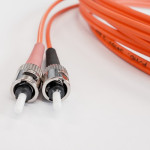Security Camera Cables: Ethernet Vs. Fiber Optic
When installing a new surveillance system, whether at home or for your business, there are many factors that need to be considered. Aside from choosing the proper security cameras, devices, and management software, security camera cables are important and often overlooked.
Security camera cables are crucial to your surveillance system as they are responsible for power and data transmission within your system. You will likely be upgrading your system from analog closed-circuit television (CCTV) to an Internet protocol (IP)-based system. Thanks to special parts called encoders, if you are only upgrading your legacy system, you can keep your analog cameras and coaxial cabling in place. The encoders convert the analog output of the camera for use by an IP-based security system.
Alternately, if you are upgrading to IP cameras and want to keep coaxial cable in place, you would need to install adapters at both the device and the switch (coaxial cable cannot handle the digital output of the cameras).
Encoders and adapters are merely affordable, short-term solutions. And because they introduce new points of failure, they can become costlier in the long run.
IP Camera Systems Cables
Upgrading your system includes your security camera cables as well. For IP-based systems, there are two choices: Ethernet (copper) cable or fiber optic (glass) cable.
Ethernet Cable
Made from twisted copper wires, Ethernet cables carry data using an electrical current. Cat 5e is currently the most commonly used in home applications and can support speeds of up to 1,000 Megabits per second (Mbps) over 100 meters (m). Cat 6, 6a, 7, and 8 cables are more commonly used in business and data centers as they can handle larger data transfers, ranging from 10-40 Gigabits per second (Gbps).
Fiber Optic Cable
Fiber optic cables use light to send digital data along flexible, optically pure glass or plastic fibers that are about the width of a human hair and enable rapid movement of data. There are two types (single or multimode) which determine the speed and length of data transmission. The differences between the two types are significant and dictate how each is used.
- Single-Mode Fiber
Because it has a narrow core of optical glass surrounded by highly reflective cladding, single-mode fiber only carries data via a single mode of light (typically transmitted by laser). This allows for lower attenuation (data loss) over longer distances and, thus, is ideal for use in high bandwidth runs (ex. telecom and communications companies, college/university campuses).
- Multimode Fiber
Multimode fiber has a larger core, allowing several different light signals (more data) to pass through simultaneously. With a larger core comes narrower cladding, which results in more data attenuation. With that said, multimode fiber is better suited for shorter distances (ex. transmitting data and signals across a local area network).
Ethernet Vs. Fiber Optic Cables
Choosing between the two options will depend on your individual needs. Here’s a look at the strengths and weaknesses of each.
Data Handling, Speed & Distance
- Ethernet cable has improved over time, with the Cat 7 and Cat 8 able to support up to 25 Gpbs to 40 Gbps over 30 m runs. Unfortunately, regardless of category, copper has a much higher attenuation rate, which only increases with the distance of the run. Thus, you would need to install an amplifier or repeater for every 100 m (328ft) of cable.
- Fiber optic cables are the better choice, as multimode cables can reliably handle 40 Gbps and up to 100 Gbps depending on the quality of the cable. Speed and distance depends on the light mode, but fiber can reliably transmit data between 610-2,000 m (2,000-6,562 ft) before the signal requires amplification.
Usability, Safety & Security
- Ethernet cabling is straightforward and ideal to use in tight spaces since copper is a flexible metal and can bend a great deal before it succumbs to the stress. However, these cables pose very minimal fire hazard risk, particularly if they are used to carry power to a device (such as an outdoor security camera). And if you are running Ethernet cables to outside cameras (ex. on light poles in parking lots, at the edge of a property), there is also a risk of attracting a lightning strike. In addition, they also post a security risk since they tend to leak data, and are also susceptible to outside interference (ex. electrical sources, other data cables).
- Fiber optic doesn’t radiate data signals at all and provides good security, but it’s not without its faults. Because it is made of glass, despite its flexibility, there is a chance for breakage if bent too far. There is also a greater chance of damaging the cable during installation or during some later construction, and it is difficult to properly splice it. These concerns should be raised with vendors you speak to before purchasing.
Cost
- Ethernet is more affordable in the short term. The cable, its components, and installation tend to be cheaper thanks to its ease of use. However, these tend to require more regular maintenance, thus increasing ownership costs over time.
- Fiber optic is definitely more expensive up front, as cost of cables (especially single mode) and installation are much higher. Despite this, it has a lower ownership cost over time thanks to less maintenance (compared to copper). Also, the cables can more easily handle expanded bandwidth without having to run new cable.
While both Ethernet and fiber optic cables have their advantages and disadvantages, it really depends on your security needs. Have you chosen between the two? Share your experience with us on Facebook, Google+, Twitter, LinkedIn, and Pinterest.
For a great selection of CCTV security cameras, systems, and surveillance equipment, please visit SecurityCamExpert.com or call 888-203-6294 today!
